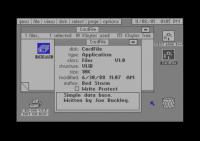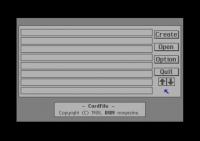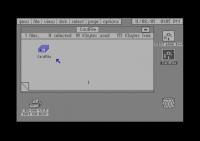| Download details |
|
CARDFILE IS A GENERIC card-file, Rolodex-type database program,with several unusually interesting features. For example, you can define up to eight field names, with a maximum of 12 characters each, for custom file storage. The program has alphabetic sorting ability, with a user-definable sort field, and it allows searches, using from one to eight fields. In all, it allows up to 30 characters per field. You can have up to 125 cards per file and multiple files perdisk. The program also supports one or two drives. Using CardFile is very easy, you just point with the mouse or joystick and click the appropriate button. The program does the rest. Here are the options available. 1. Create—You can call this option at any time to make new files as needed. When you select it, you'll be asked for a name for the new file and which drive you wish to have the new file written to(if you're using a two-drive system). Once you select Create, you must generate names for up to eight fields. The text cursor will appear in the first field and remain until you press the return key. Then it will automatically drop down to the second field, and so on, until you have entered all the strings you wish. It's not necessary to name all the fields, but doing so will avoid future confusion. But if you decide you don't want to use one or more of the fields, just press return to skip them. Once you've entered all your field names, a dialog box appears, asking you to define the sort field for the file. Each new card, when entered, will be inserted into the file in in alphabetical order. This alphabetic insertion is keyed to the text in only one of the eight fields. This is called the sort field, and you define it when you originally create the file. When finished, your valid but empty file is complete and ready for inputting data. 2. Open—At any time you're using the program, you may open a new file by selecting this option. Once you've opened a file, you can add data to it, search for previously entered information or modify old data. 3. Options—This icon calls a dialog box with all the choices you need in order to enter change or remove cards from a file. Here are the choices. • Search. This option allows you to search all cards for the text strings you supply in one to eight fields. The program treats the search string as a substring, so any occurrence within the card field will generate a match (e.g., searching for "in" will match "within"). Once Search is selected, merely click the field you wish to search. Then enter any valid text string, ending with a return. The search is not case-sensitive, so any text may be entered in lowercase. You may, if you wish, enter text in any of the other fields as well. The search is done only on a field-by-field basis. (By that, I mean text in field 1 is only compared to text in field 1.) When ready, select theOK icon; or select Cancel to abort. If only one text field is being searched, the program continues. If you've chosen more than one field to search in, a new dialog box appears. You'll be given the choice of an AND search or an OR search. Select AND if you only wish to see the cards that have a match in all of the fields you are searching through, Select OR if you wish to see any cards where there is a match in any one field. When a matching card is found, it is displayed on the screen. If you wish to continue with the search, looking for more matches,select OK. If you wish to use, remove or change the card, select Cancel. This aborts the search and returns you to the main level with the matched card displayed. • Insert. You use Insert to write a new card into the file. When Insert is activated, just click the mouse in a field in which you wish to enter text. A return ends text entry. You may finish at one field or click again on the same field to change your entry, or click in a new field to enter text there also.
When you're finished entering text, select OK to add the card to the file, or select Cancel to abort and return to the main level. If OK, the new card will be inserted alphabetically according to the text in the sort field. • Delete. This option removes from the file in the currently displayed card page. A dialog box appears, allowing you to confirm or deny the deletion request. Be sure, because once deleted, it's really gone!
• Modify. Modify allows you to alter the text of a pre-existing card. As with Insert, merely click over the field you wish to change and retype the text. And, just as with Insert, you may change more than one field. When you're ready, select OK to enter the modified card into the file, or select Cancel to abort the changes. Since the text of the sort field may have been changed, altering what should be its proper position, the card is reinserted into the file according to the current text within the sort field. • OK. This option merely returns you to the main program with no changes to the file. 4. Quit—This does just what it says: quits the current file and returns you to the deskTop. One other feature of CardFile is the ability to import and export cards as text scraps. To copy the current card to a text scrap, press the shift and C keys simultaneously. The text scrap will be arranged with each card's text separated by a carriage return. To import a text scrap, use shift/T. The text will be read in, placing up to 30 characters in each field. All extra text will be ignored until a carriage return is encountered. Blank fields will result from insufficient text. Note: I found lots of copies of this running around the internet, but most were corrupted. They would launch, but the delete or modify function would crash the program. |
|
|||||||||



